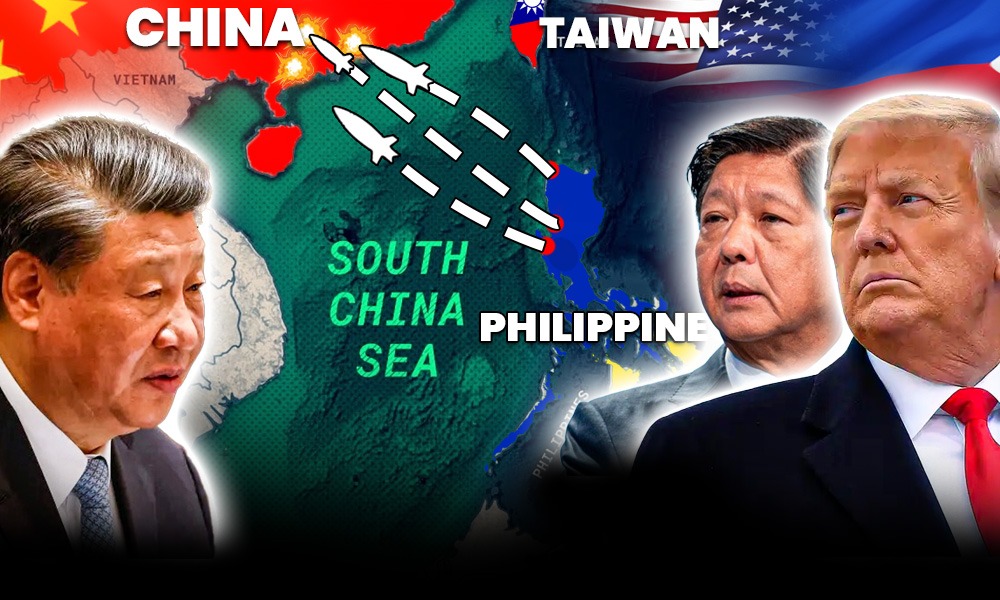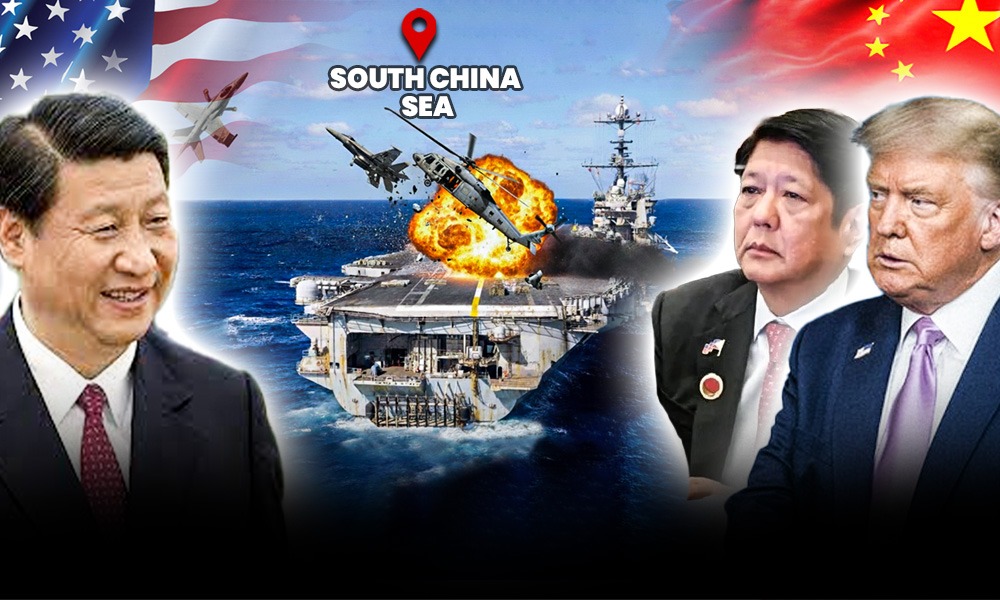BREAKING: The largest-ever Balikatan exercises have begun with 17,000 troops deploying advanced missile systems near Taiwan Strait as tensions with China escalate.
“They’re watching every move we make,” muttered Lieutenant James Wilson, tracking a suspicious vessel through his binoculars from the command post overlooking Palawan’s western shore. “Third foreign surveillance ship this morning.” Philippine Marine Captain Ana Santos nodded grimly. “Just like the confrontation in Scarborough Shoal last month. They push, we stand firm, they call it provocation.” The command centre hummed with activity as American and Filipino officers coordinated the unprecedented joint deployment of NMESIS anti-ship missile systems, a clear message to Beijing after months of increasingly dangerous encounters in disputed waters.
“President Marcos arrives in two hours for the missile defense demonstration,” Santos said, checking her watch. “Intel reports unusual movement near the Taiwan Strait.” Wilson lowered his binoculars. “This isn’t just another exercise anymore, is it?” “Not since Defense Secretary Hegseth announced doubling down on our alliance,” Santos replied. “When Lieutenant General Glynn said ‘nothing builds bonds more quickly than shared adversity’ this morning, everyone knew exactly what adversity he meant.”0
Outside, the tropical heat shimmered above the landing zones where Marines from both nations moved with practiced precision, their shoulder patches, American and Filipino, side by side under the unforgiving sun, embodying the “Balikatan” spirit as storm clouds gathered on the horizon.
“Seventeen incursions in the past month, a 340% increase since January,” Colonel Javier Santos reported, sliding satellite images across the tactical display as U.S. Marine Commander Alexandra Reyes studied the Philippine Sea boundaries now dotted with foreign vessels.
“That’s why we’ve repositioned our NMESIS batteries to cover these three critical chokepoints,” Reyes replied, marking coordinates on the digital map where advanced missile systems would create overlapping fields of deterrence across the archipelago’s vulnerable eastern approaches.
Philippine Defense Minister Carlos Batangay entered the command center, acknowledging the officers with a nod. “Washington just confirmed the additional P-8 Poseidon surveillance flights, four daily rotations beginning tomorrow. President Marcos wants to know if that’s sufficient coverage for our joint maritime awareness initiative.”
“It triples our monitoring capability,” Reyes answered, “especially with the new AI-enhanced recognition systems identifying vessel types with 97% accuracy. The Chinese maritime militia can’t disguise their movements anymore.” Outside the reinforced operations bunker, battalions of Filipino and American troops conducted synchronized amphibious landing exercises, the first of eight planned joint operations across previously vulnerable islands where China had contested territorial claims. Military analysts called it the most significant strengthening of the 1951 Mutual Defense Treaty in decades, transforming symbolic military cooperation into an integrated defense strategy with real tactical capabilities and shared command structures.
“FOB Sentinel is operational,” Lieutenant Colonel Maria Rodriguez announced, her voice carrying across the command center where American and Philippine officers tracked deployment progress on real-time digital maps. “That completes our network of forward positions spanning the entire eastern maritime approach.”
Marine Captain James Wilson nodded, updating status markers on his tactical display. “Logistics corridors secured between all six locations. Supply chains now operating at 94% efficiency despite the challenging island terrain.”
“The coastal radar integration is complete,” Philippine Navy Commander Dante Reyes added. “Our maritime awareness grid now covers 78% of contested waters with overlapping surveillance zones. Chinese vessels can’t approach within 50 nautical miles of our outlying territories without detection.”
Outside, CH-53K King Stallion helicopters thundered overhead, ferrying defensive equipment to reinforce the Philippines’ westernmost islands—territories previously vulnerable to foreign encroachment due to limited military presence.
“The Admiral wants an update on the amphibious defense drills,” Wilson said, reviewing after-action reports from the morning’s exercises.
“Fifth Battalion reduced response time to under 27 minutes,” Rodriguez replied. “That’s a 40% improvement over last quarter’s capabilities assessment. The integrated command structure is working.”
Beyond the command center windows, joint patrol vessels departed for another monitoring rotation through disputed waters, their advanced electronic surveillance systems capable of distinguishing between fishing boats and disguised maritime militia. In the distance, Marine units practice rapid coastal fortification techniques designed to transform vulnerable beach approaches into defensible positions within hours—a capability deemed critical for protecting the scattered island territories that had increasingly become flash points in regional territorial disputes.
https://indopacificreport.com/2025/04/23/italys-philippine-submarine/
“This isn’t just about boots on the ground anymore,” Admiral Sarah Chen remarked, gesturing toward the holographic display showing defense arrangements spanning the South China Sea. “It’s about creating an integrated deterrence network that makes aggression too costly to contemplate.”
Philippine Defense Secretary Ramon Alvarez nodded, studying the deployment patterns. “The second Typhon array changes the strategic calculus entirely. Beijing’s freedom of movement in these waters drops by 60% overnight.”
“And that’s before factoring in our new trilateral exercises with Japan,” added U.S. Marine General Michael Torres. “Their maritime self-defense forces join us next month for the expanded Balikatan operations.”
A junior officer approached with a tablet displaying recent intelligence. “Sir, our diplomatic channels report China has called an emergency meeting with ASEAN representatives. They’re proposing new economic incentives to nations willing to limit foreign military presence.”
“The classic carrot approach,” Torres observed. “While they’re offering infrastructure investment packages with one hand, they’re establishing new artificial island outposts with the other.”
“Which is precisely why our approach goes beyond military countermeasures,” Chen replied. “The new security assistance packages for Vietnam, Malaysia, and Indonesia include not just hardware but comprehensive maritime domain awareness systems. Five billion in total, with another three billion for economic resilience programs.”
Outside the command center, Filipino and American forces conducted integrated coastal defense simulations, practicing rapid reinforcement scenarios across the archipelago’s scattered islands, once isolated outposts now transformed into key nodes in an expandable defensive network that could rapidly incorporate Japanese, Australian, and potentially Taiwanese forces in a crisis scenario.
“Twenty years ago, we conducted symbolic exercises,” Alvarez said quietly. “Today, we’re reshaping the entire regional security architecture.”
Reshaping Regional Security: A New Era in the South China Sea
As dawn breaks over the contested waters of the South China Sea, the joint deployment of U.S. and Philippine Marines represents far more than a routine military exercise. It signals a fundamental shift in regional security dynamics that will reverberate across Southeast Asia for years to come.
The establishment of forward operating bases across strategic Philippine islands, coupled with the deployment of advanced Typhon missile arrays and integrated surveillance networks, has effectively created a new defensive perimeter that challenges long-standing assumptions about power projection in these disputed waters.
“This isn’t simply about countering any single nation’s ambitions,” noted regional security analyst Dr. Elena Santos. “It’s about establishing a sustainable security architecture that preserves freedom of navigation and territorial integrity for all regional stakeholders.”
As military partnerships deepen and expand to include other key allies like Japan, Australia, and potentially additional ASEAN nations, the strategic calculus has fundamentally changed. What began as bilateral exercises has evolved into a sophisticated multilateral defense framework with diplomatic, economic, and informational dimensions complementing traditional military approaches.
The message being sent across the region is unmistakable: the era of unchallenged maritime expansion is over, replaced by a networked defense strategy that makes territorial aggression prohibitively costly. For nations throughout Southeast Asia watching these developments, the implications are profound, a new balance of power is taking shape, one that may ultimately determine the future of this crucial maritime crossroads.
U.S. Deployed Anti-Ship Missiles in the Philippines to Deter China!



